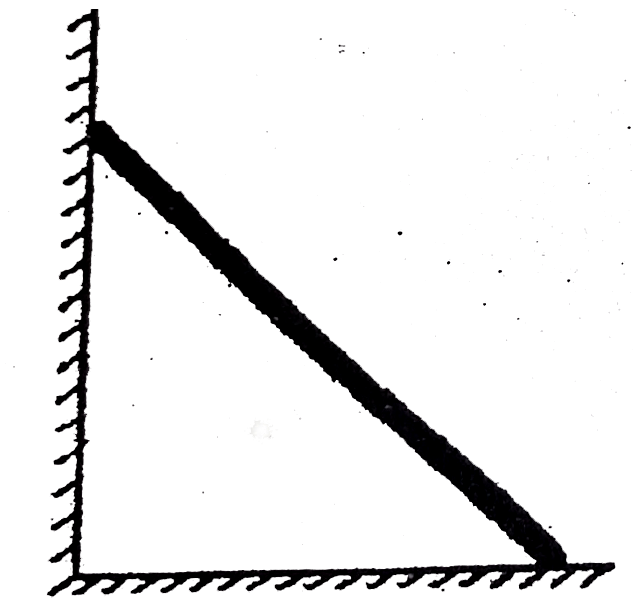A man is at the top of a ladder and another instance he stands on one of the lower steps. In which case does the foot of the ladder have a higher chance of slipping ?
The correct Answer is:the man at the top of the ladder
Topper's Solved these Questions
- STATICSBOOK - CHHAYA PUBLICATIONCHAPTER - STATICSEXERCISE - Very Short Answer Type Questions ( Based on Centre of Gravity )
8 Videos
- STATICSBOOK - CHHAYA PUBLICATIONCHAPTER - STATICSEXERCISE - Short Answer Type Questions -I
2 Videos
- STATICSBOOK - CHHAYA PUBLICATIONCHAPTER - STATICSEXERCISE - Very Short Answer Type Questions ( Based on Moment of a Force )
1 Videos
- SIMPLE HARMONIC MOTIONBOOK - CHHAYA PUBLICATIONCHAPTER - SIMPLE HARMONIC MOTIONEXERCISE - CBSE SCANNER
16 Videos
- SUPERPOSITION OF WAVESBOOK - CHHAYA PUBLICATIONCHAPTER - SUPERPOSITION OF WAVESEXERCISE - CBSE Scanner
14 Videos
Similar Questions
A light ladder rests onn te rough floor of a room, leaning against a smooth wall. The ladder touches the wall at height h above the floor. A man climbs up the ladder until the base of the ladder is on the verge of slipping. The coefficint of static friction between the foot of the ladder and floor is μ.
(a) What is the horizontal distance moved by the man?
(b) Solve part (a) if the ladder is uniform and has the same weight as the man and the base of the ladder is at a distance l from the wall.
View SolutionA man X goes to the top of a building by a vertical spiral staircase. Another man Y of the same mass goes to the top of the same building by a slanting ladder. Which of the two does more work against gravity and why ?
View Solution
Knowledge Check
A ladder leans against a wall if the ladder Is not to slip which one of the following must be true?
 Athe coefficient of friction between the ladder and the wall must not be zeroBthe coefficient of friction between the ladder and the floor must not be zeroCBoth A and BDEither A or B
Athe coefficient of friction between the ladder and the wall must not be zeroBthe coefficient of friction between the ladder and the floor must not be zeroCBoth A and BDEither A or BA ladder, metres long standing on a floor leans against a vertical wall . If the top of the ladder slides downwards at the rate of 10 cm/sec , then the rate at which the angel between the floor and the ladder is decreasing when the lower end of the ladder is 2 metres away from the wall is
A110 radian/secB120 radina/secC5 radian/secD10 radian/ secA ladder 6.5 m long is standing against a wall and the difference between the base of the ladder and wall is 5.2 m. If the top of the ladder now slips by 1.4 m, then by how much will the foot of the ladder slip?
A1.2 mB0.8 mC0.75Dcan't be determined
A ladder 13 m long is leaning against a wall. The bottom of the ladder is pulled along the ground away from the wall at the rate of 4 m/sec. Find the rate of decreasing at which the top of the ladder moving downwards on wall when the foot of the ladder is 5 m away from the wall.
View SolutionThe top of a ladder 6 metres long is resting against a vertical wall on a level pavement, when the ladder begins to slide outwards. At the moment when the foot of the ladder is 4 metres from the wall, it is sliding away from the wall at the rate of 0.5 m/sec. How fast is the top-sliding downwards at this instance? How far is the foot from the wall when it and the top are moving at the same rate?
View SolutionThe top of a ladder 6 metres long is resting against a vertical wall on a level pavement, when the ladder begins to slide outwards. At the moment when the foot of the ladder is 4 metres from the wall, it is sliding away from the wall at the rate of 0.5 m/sec. How fast is the top-sliding downwards at this instance? How far is the foot from the wall when it and the top are moving at the same rate?
View SolutionA ladder 6.5 m long is standing against a wall and the difference between the base of the ladder and wall is 5.2 m. If the top of the ladder now slips by 1.4 m, then by how much will the foot of the ladder slip?
View SolutionA ladder 13 m long is leaning against a wall. The bottom of the ladder is pulled along the ground away from the wall at the rate of 4 m/sec. Find the rate of decreasing at which the top of the ladder moving downwards on wall when the foot of the ladder is 5 m away from the wall.
View Solution
